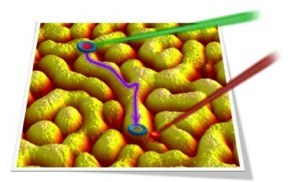Looking Inside Organic Solar Cells

Organic solar cells form an emerging area of photovoltaics, which promises to substitute traditional silicon solar modules for niche applications. To convert the sun energy into electricity in such a device, a bulk heterojunction is used, which is a phase-separated mixture of donor- and acceptor-type organic semiconductors. Achieving the highest power conversion efficiencies requires thorough control of the nanoscale structure of the bulk heterojunction, the so-called morphology. As the typical phase separation of the two materials occurs in 10 nm region, the morphology is extremely hard to study by conventional microscopic techniques.
The Optical Condensed Matter Physics and Polymer Science groups at the Zernike Institute for Advanced Materials have recently developed an all-optical method to determine key information on the morphology of the bulk heterojunction. Using a combination of ultrafast spectroscopy and kinetic Monte-Carlo simulations, they captured morphology features with nanometer spatial resolution. Independent verification of morphology reconstruction by microscopic and surface-sensitive X-ray scattering techniques demonstrated the validity of the all-optical approach. As the proposed technique is non-invasive, it can be used for on-the-fly characterization of fully functional devices thereby opening exciting perspectives for developing high-efficient organic optoelectronics.
The results of this work are published in
Serbenta, A. et al. Bulk heterojunction morphology of polymer:fullerene blends revealed by ultrafast spectroscopy. Sci. Rep. 6, 36236; doi: 10.1038/srep36236 (2016)
| Last modified: | 08 November 2016 1.19 p.m. |
More news
-
24 March 2025
UG 28th in World's Most International Universities 2025 rankings
The University of Groningen has been ranked 28th in the World's Most International Universities 2025 by Times Higher Education. With this, the UG leaves behind institutions such as MIT and Harvard. The 28th place marks an increase of five places: in...
-
05 March 2025
Women in Science
The UG celebrates International Women’s Day with a special photo series: Women in Science.
-
16 December 2024
Jouke de Vries: ‘The University will have to be flexible’
2024 was a festive year for the University of Groningen. In this podcast, Jouke de Vries, the chair of the Executive Board, looks back.
